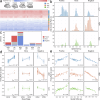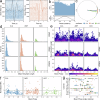The human claustrum tracks slow waves during sleep
- PMID: 39419999
- PMCID: PMC11487173
- DOI: 10.1038/s41467-024-53477-x
The human claustrum tracks slow waves during sleep
Abstract
Slow waves are a distinguishing feature of non-rapid-eye-movement (NREM) sleep, an evolutionarily conserved process critical for brain function. Non-human studies suggest that the claustrum, a small subcortical nucleus, coordinates slow waves. We show that, in contrast to neurons from other brain regions, claustrum neurons in the human brain increase their spiking activity and track slow waves during NREM sleep, suggesting that the claustrum plays a role in coordinating human sleep architecture.
© 2024. The Author(s).
Conflict of interest statement
The authors declare no competing interests.
Figures







Update of
-
The human claustrum tracks slow waves during sleep.bioRxiv [Preprint]. 2024 Jan 30:2024.01.29.577851. doi: 10.1101/2024.01.29.577851. bioRxiv. 2024. Update in: Nat Commun. 2024 Oct 17;15(1):8964. doi: 10.1038/s41467-024-53477-x. PMID: 38352615 Free PMC article. Updated. Preprint.
References
Publication types
MeSH terms
Grants and funding
LinkOut - more resources
Full Text Sources

